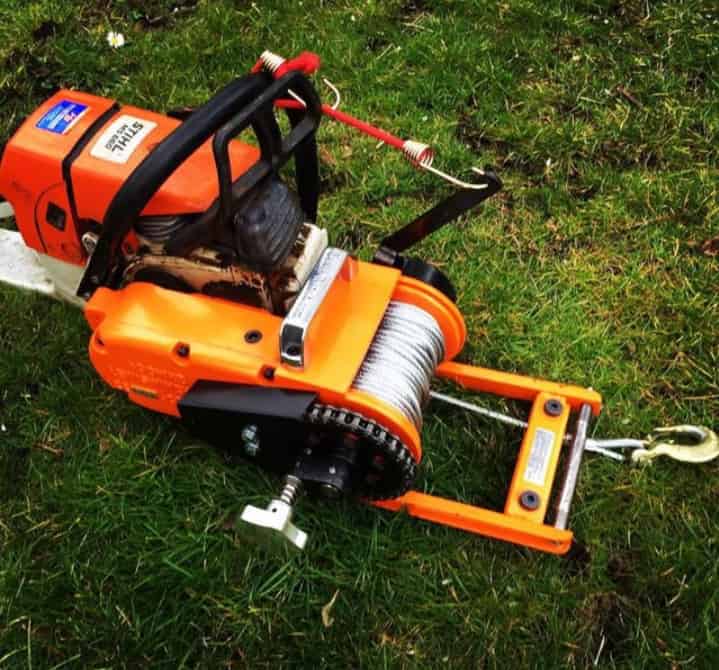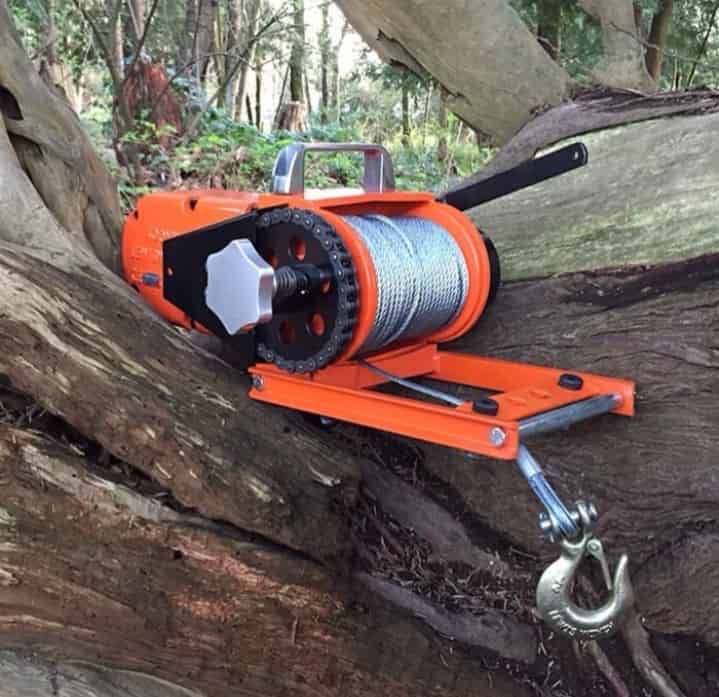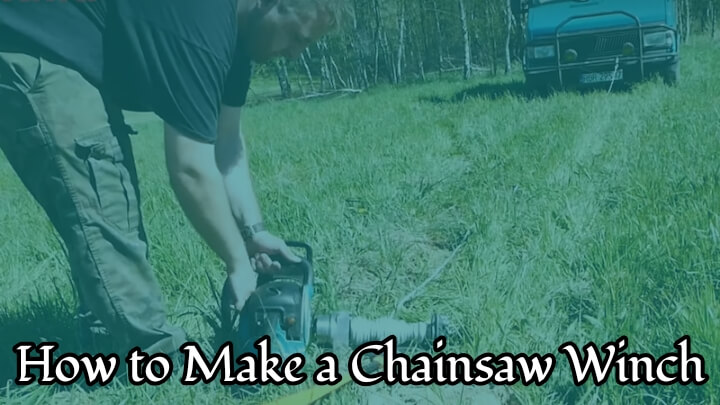If you’re looking for an easy way to move logs or large pieces of wood, a chainsaw winch might be the perfect solution.
This simple device can help you easily and safely lift heavy objects with your chainsaw.
In this article, we are going to give you a step-by-step guide on how to make a chainsaw winch.
Table of Contents
What you need
- Chainsaw
- Carabiners
- Rope
- Sawhorses
- Safety goggles
- Ear protection
- Chain oil
- Pipe clamps
- Vice clamps
- Building plans (optional)
Check out: best chainsaw helmet
Easy Steps to Making Your Chainsaw Winch Last Longer
The first thing that you need to do is gather all of the necessary materials. The list of materials includes a chainsaw, carabiners, rope, saw horses, safety goggles, ear protection, chain oil, and pipe clamps. If you want to build the winch according to our plans, you need to get building plans.

Step 1: Fasten the saw horses together with carabiners to create a stand for up-righting the chainsaw to attach the rope to it. Ensure that it is securely fastened so that your chainsaw does not fall over when you are pulling it out of a deep ditch or mud.
Step 2: Scribe two circles onto each pipe clamp using a pencil, making sure that they are identical in diameter and circumference. Drill holes using an electric drill on either side of both circles where you want to place screws into them from one side.
Be sure to use a drill bit that is slightly smaller in diameter than the screws you are using. This will help to prevent the wood from splitting when you screw it in.
Step 3: Place the pipe clamps onto the circular marks on the sawhorses, and ensure that they are lined up evenly before securing them in place with screws.
Step 4: Take the vice clamps and place them around each end of the Rope ensuring that there is an equal amount of rope on either side of the clamp. Make sure that the rope is not twisted before clamping it in place.
Step 5: Drill a hole through each side of the rope clamp using an electric drill, making sure that the hole is big enough for the sawhorses to go through so that they are flush.
Step 6: Place either side of the rope through each hole in the vice clamps, and then, and then push it down between the two sawhorses. The sawhorse should be facing downwards when you are pushing it through.
Step 7: Place your chainsaw into the vice clamp on top of the rope that is standing upright with the oil reservoir facing upwards just below it.
Make sure that there is enough slack in both ends of the rope to attach them onto their respective carabiner hook in step 9.
Attach one end onto a carabiner hook attached to a chain saw handle, and attach another carabiner hook an empty part on the other side of the chainsaw handle.
Step 8: After you have attached a carabiner hook to a part of your chainsaw handle, loop the other end onto the other carabiner hook and attach it onto another part of your saw handle opposite to where you attached one before.
Make sure that you do not twist the rope when connecting this end down. Doing so may cause it to fray or break. The exact location where you should attach your second carabiner depends on how much slack is left after cutting off excess in step 12.
Step 9: Use a piece of wire (or any sturdy material) and make a circular shape using two loops made at either end allowing for an opening through which you will be able to attach a carabiner hook.
Step 10: Feed the wire through the pipe clamp and make sure that it does not go through too far as you will want to be able to attach your carabiner later on.
Make two loops on either end of the wire with one end going through an opening (possibly where there is already cut out) in the vice clamp, and another end going through an opening coming from the other side of the vice clamp.
Step 11: Put oil onto your chainsaw’s bar and chain so that they can move freely around without much resistance when rotating them. If you do not do this, then chances are that your rope may break or fray because it has become snagged on parts of your saw’s body.
Step 12: Loosen the vice clamp on your saw by undoing the screw that was holding it in place to allow for some slack. Start cutting into the log or object that you are trying to lift out of the ditch or mud hole using your chainsaw.
Continue cutting until you have cut about three-quarters of the way through, making sure not to slip with your chainsaw otherwise this will cause injury. You can also use a large stick or something similar as leverage when cutting deeper into whatever is trapping your saws underneath it.
Then tighten up your vice clamp again so that there is just enough slack left within the rope’s ends for them to be attached to their respective carabiner hooks in step 15 without it being too tight or loose.
Step 13: Place the chainsaw winch on a stable surface before attaching the carabiner hooks onto the ends of the rope.
Step 14: Push down on the chainsaw handle so that the chainsaw’s bar and chain are pressing down into the log or object you are trying to lift. This will cause the sawhorses to start lifting it upwards.
Step 15: Keep your hands firmly on the chainsaw handles, and slowly release your pressure off of it once you have seen that the chainsaw is no longer cutting into the log or object. This means that it has been successfully lifted out from where it was stuck. If done correctly, there should now be very little slack left in the rope.
Properly maintain your chainsaw winch
Chainsaw winches are an important part of any chainsaw owner’s equipment and should be properly maintained to ensure long-term use. Here are 6 tips for proper chain saw winch maintenance:
- Regularly clean the chain and sprocket with a degreaser and brush.
- Lube the gears with a light oil every few months or when they start to sound noisy.
- Check the tension on the cable every time you use the chainsaw winch, and adjust as necessary.
- Replace worn parts as needed, such as cables, pulleys, bearings and screws.
- Keep your chainsaw winch in good working order by keeping it clean and lubricated.
- Store your chainsaw winch away from moisture and debris to prevent corrosion.
Tips for using your chainsaw winch
If you’re using your chainsaw winch to haul something heavy, be prepared to do some serious straining. Follow these tips for using your chainsaw winch safely and effectively:
1. Make sure the chain is tight. Loosen it up a bit before you start hauling so that it doesn’t slip and cause damage.
2. Use the right kind of cable. A thick, durable cable will last longer than a thin one.
3. Keep an eye on the tensioner arm. It should move smoothly and steadily along the cable when you’re pulling on it. If it wobbles or makes loud noises, your cable is too taut and needs to be loosened up a bit.
4. Get help if necessary. If you can’t handle the strain, get someone else to help you out – Chainsaw Winch Safety First!
How do you use a winch on a chainsaw?

Chainsaws are great tools for the homeowner or professional, but if you want to use them the way they were meant to be used, you’ll need a winch. A winch can help you pull heavy objects like logs or even a tree down from a high place. Here’s how to use a winch on a chainsaw:
- Attach the winch to the chainsaw chain.
- Put the other end of the chainsaw chain around whatever you’re trying to pull down.
- Turn on the chainsaw and let it run until it’s in gear, then start your engine and give it some power.
- Hold onto the chain with one hand and hold onto the handle of the chainsaw with your other hand, and watch as the object comes down!
How much can a chainsaw winch pull?
Chainsaw winches are a great way to pull heavy objects. They can pull objects up to 6000 lbs. They have a range of pull strengths from 2000 to 5000 lbs.
How much can a Lewis winch pull?
The Lewis Winch is a dependable and powerful device that can pull a great deal of weight. In fact, the Lewis Winch has been known to pull up to 4000 lbs!
This makes it a perfect tool for use on ATVs, trucks, and trailers. Because of its power and versatility, the Lewis Winch is a popular choice for many outdoor enthusiasts.
Final thought
If you find that there is still some slack left in the rope after completing all of the steps, then go back to step 12 and cut into the log or object a bit deeper.
This will ensure that there is no excess slack left in the rope when you are finished. If there is already very little slack left within the ropes, then it is best not to cut any further as it may cause damage to your chainsaw or even injure someone.
You may like our articles on How To Untangle Chainsaw Chain and How to Hold Logs While Cutting with a Chainsaw.

